Testimonies
Here is a selection of testimonies submitted to us via e-mail or Facebook, and originally published on our Hungarian-language website. These testimonies were selected and, unless stated otherwise, translated into English by Gwen Jones. To submit a story, please write to bertalan@ceu.edu.
2014. February 20., Thursday

My grandfather’s workshop and business were at Kazinczy Street 51. He ran the shop with his younger brother who, by 1944, had already been a prisoner of war for a long time, somewhere near Minsk. My father was taken to his last forced labor service in the spring of that year. They were clearing forests and constructing defense lines in the Carpathians. After liberation, he returned to the capital and immediately started up the business again, with survivors. Their first job was from the Soviet command, making the letters and metal ornaments for the memorial on Gellért Square. The army gave them the raw materials and food too.
Behind the large windows on the ground floor, they sold their own products in the shop. My mother served from behind the counter. At the back was the workshop. The workers sat around a massive work-table. What I remember: making ornaments from shining sheets of brass, which they decorated with “markazi” stones and polished. On the first floor was an office and maybe a storeroom. They also made inexpensive plastic (“trolitur”) ornaments, pressed in series. As far as I recall, they tried to make Walt Disney figures as well (e.g. Bambi, the Seven Dwarves, etc.), but were never refunded the large investment for a special press because of the large rights payments demanded by the Disney company. When I wasn’t at school, I often went to the workshop. When I ended up in the countryside, I didn’t go there for a year. When I visited my parents again, I was happy to meet the surviving workers whom I knew well. There were some who never came back, but most of the workers there were old friends.
2014. February 19., Wednesday
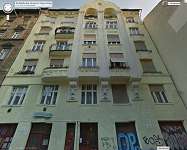
Akácfa Street 43 was also a yellow-star house. I moved in here together with my mother in in June 1944, because this is where my grandparents lived, Rezső and Rózsa Tannenbaum, and their daughter Margit. Later, my mother’s two older sisters, one with her husband, also moved in. There were 8 of us at my aunt and uncle’s, in a small apartment with 2.5 rooms, and we hardly had anything to eat. It was from here I attended the Madách high school wearing my yellow star, as long it was still possible to attend school.
On October 13 my father, István Weisz, received 2 or 3 days’ release from the forced labor camp and came home, and when he left us to return on October 15, the day of the Arrow Cross putsch, he was caught by the Arrow Cross and, half beaten to death, staggered home into the house. Two days later he was caught by them again, and taken to Buchenwald, from where he never returned. Today, the house’s façade has been restored, but inside it is exactly the same as it was before. The house later fell within the territory of the ghetto.
When we received the news that they intended to set the closed Pest ghetto on fire, a group of resistance activists dressed as the Arrow Cross came in November to rescue us from Akácfa Street 43. They escorted 8 of us to the protected house at Szent István Park 25. I was 13 years old at the time. My older sister was already waiting for us there, and so nine of us occupied a corner of one room in a first-floor apartment. There were at least 4 other families living in the apartment, the windows had been smashed and it was often -15C outside. We burned almost all the furniture to keep warm, and hardly had enough to eat. The plumbing only worked in the basement. The Arrow Cross gathered us together in front of the house on two occasions, with the clear intention to shoot us at the Danube, which was barely 80 steps away. Both times, we referred to the Arrow Cross leader living in the next-door house, and both times they let us go. On January 15, the Russians occupied the house, but for a long time we had nowhere to go, and stayed there starving until at least February or March 1945.
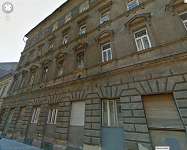
My family and me were in the “Csillagos ház,” Wessélenyi Street 61 in 1944. We were cramped in a small apartment on the second floor with two other families. We were five of us, I was only 10 years old and it was very difficult and full of suffering for all of us. My father was only able to work on selected days and we just hardly made it. On October 19th, the Arrow Cross thugs took my father, and that was the day when I saw my beloved father the last time. He was killed by the Arrow Cross. On November 1st with the help of my late uncle who worked in the Swedish Embassy, we were able to escape and my younger brother and I were placed in a “safe house” in Lónyay Street 9, which had Swedish protection. My mother and older sister were placed in a Catholic Convent which was also “protected” by the Swedish Embassy. Raoul Wallenberg was the hero and I vividly recall that one day in November, Raoul Wallenberg personally came to save us from the Arrow Cross thugs. Mid-December 1944 we had to escape from the “safe house” because the most horrible Arrow Cross thugs wanted to take us. My mother felt that we should walk to the Ghetto. While we walked in the city the Arrow Cross members stopped us and transported us to one of their “Terror Houses” which was on Andrassy Road 47 (near the Octogon). The Arrow Cross Thugs were the most primitive murderers and as a 10-year-old I saw just killing, blood and the worst human suffering. After almost 70 years I’m still suffering from that unbelievable experience!
From Andrassy Road 61 in early January, 1945, the Arrow Cross were taking us to the Danube for execution but the leading Arrow Cross member was drunk and the older people in the group convinced the Arrow Cross guy (Nyilas) to walk us into the Ghetto. January 18, 1945 the Russians liberated the Ghetto and we were the few lucky survivors. During the Holocaust (vészkorszak) I lost 17 of my immediate family, my father, older brothers, aunts, uncles and several cousins. I told this sad story to several young and older people, both Jews and Gentiles. The entire world must forever remember for the Holocaust in the memory of the 6 million Jews murdered by the Nazis. (Although “New Nazis,” the “New Arrow Cross” in Hungary, Iran and other Thugs are claiming that the “Holocaust is a myth”... This is the main reason that Israel must be very important for every Jewish person and for Gentiles as well.
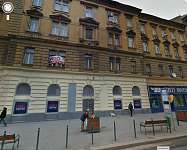
I remember: my father was somewhere in Russia “defending the homeland,” and my mother stayed at home with 2 children, in those dreadful times. One day she started coughing blood, it was diagnosed as tuberculosis. We were moved to somewhere in Zugló near the church with my mother in this state, this was the first yellow-star house.
My grandmother hurried to help us. My mother ended up in the János hospital in Buda, and we children “moved” with our grandmother into the second yellow-star house at Népszínház Street 30. I write “moved” because we didn’t move but were taken: the elderly grandparents, me, and my 4-year-old sister.
I’d already got over the humiliation when, one day, when we were still allowed to go to school, the yellow-star was not on my coat, it wasn’t visible. For this, my mother was taken to the police station and beaten. Maybe this is why she later coughed blood?
The “apartment” at Népszínház Street: 14 adults and 2 children crammed into a two-room apartment. There was a curfew, which meant our grandmother always had to hurry to reach my mother in the János hospital and come back in time. There was hardly anything to eat at the hospital, so my grandmother had to decide whether my sick mother or the children should eat. The windows looked onto what is today John Paul II Square, so we had some fresh air.
But there were good things too. I always wanted to be a teacher and we played school in the stairwell of the yellow-star house. We fell in love too, as 9-year-olds do. If there was an air-raid, we couldn’t go down into the basement, and so waited for the Stuka planes and the bombs upstairs.
And then came the next terror: October 15, 1944. We listened to the news of events, but soon had to WAKE UP to the facts, as the next day, we were taken to the Tattersaal racing track.
My uncle, who was 75 years old at the time, was kicked down the stairs. We stood there all night on the track, STANDING, my grandmother with my 4-year-old sister in her arms, and they threatened her with a pistol because my sister took a liking to some shiny object. We spent two nights like this, and by the time we came home, the apartment had been plundered.
Hanging on a nail in the pantry was a bag with flour and groats, but from outside they felt the same, and my grandmother picked the bag of groats, which she cooked in water and we ate for days. We had to read every day, without light, and grandmother taught us poems she knew off by heart. Is why I became a Hungarian teacher later? Of course, every day there were raids, and whenever they found someone in the apartment, they took them away. These were Hungarian Arrow Cross men!
And this is how we “lived” until the end of November, when ghettoization began. They led us down Népszínház and Rákóczi Street, right to Klauzál Square. That’s where they took away my doll and small basket. This was what hurt me the most. We “lived” in the Pest ghetto from the end of November 1944, in the middle of raids, starvation and illness. A bomb landed in the basement and my 4-year-old sister was evacuated from there. Forced laborers who had left their units came to find refuge. It’s there that I stole something for the first and last time in my life, some tin of preserved goods, and my grandmother gave me a great telling off.
Two months in the ghetto, during the siege of Budapest. We were liberated on January 18, 1945. Russians liberated me and my surviving relatives. They tore the yellow stars off our clothing and gave us food. And what happened after is also history, but it’s my history.
My mother died at the age of 31, and my foster-mother returned from Auschwitz. 52 members of my family disappeared, including my grandfather, who disappeared from the yellow-star house. My daughter never spent holidays in the countryside – we had no relatives living there any more. I stayed here to teach Hungarian literature, and my younger sister left 45 years ago for a far-away country. Was she the smarter one?!
Why didn’t we rebel? Dear contemporaries of today! Old people and children rebelling against armed men?
At least today I can make my voice heard and I think that’s something. That’s all for the moment. Ask away!

My family lived and was liberated in Teréz Boulevard 7. I was three years old. The Russians were already at Nyugati railway station when the Germans entered the house. They asked whether there were any Jews here, and received the answer that there were only German workers in the house. The Germans were tired, they ate and slept. Three people left the house via a drilled-out tunnel into the next house, and from there to Nyugati, and brought the Russians back to the house. For both me and the house, this was liberation.
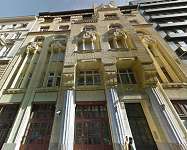
When it came time to move into the yellow-star house, a second floor apartment at Akadémia Street 7 was designated for us. My mother, her parents, my younger sister and I moved in there together into a narrow room, but at least we could be together. The apartment had originally belonged to my grandmother’s older brother, Dr. Károly Fillenz. There was a vast mount of people squeezed in there together, around 38-40 of us, most of whom were related. We only knew the other residents of the house by sight, and I remember the family name of Adler.
Horthy’s proclamation caused much excitement, but the next day the Arrow Cross broke into the house, and ordered every man aged between 16 and 60 down into the courtyard. They took away Grandfather and Uncle Károly and all the other men in the house. They never returned. Adler was the only one in the house who escaped and returned home. It’s from him that we know they were taken to Dachau, and the old ones were killed the very same hour they arrived.
Some days later more Arrow Cross men came, young men in their teens, and herded all the women together. They took our mother too. After a terrible, nerve-wracking three days, she came home. They had been taken to the Óbuda brick factory. There were thousands of them there, desperate girls and women. Our mother was rescued by a distant relative who was working as a Zionist, who didn’t wear the yellow star, and who went about in public wherever he could. He went to the brick factory to get his wife, and because he knew our mother well, he managed to bring her and a few other women out too. The yellow-star house was almost completely empty. We didn’t dare to stay there either.
A relative pointed us to Pozsonyi Road 41, which was under Swiss protection. As the photo shows, the house on Akadémia Street, with its beautiful, grand, middle-class apartments, was one of the most elegant on the street. Because of my memories connected to the place, it isn’t this beauty that I remember, but what we experienced there of the horrors, tragedies, numerous suicides, and finally our loved ones being dragged off.
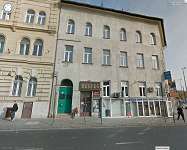
At Széll Kálmán Square 10 lived the two owners of the house, Dr. Kálmán Balkányi with his wife Edit Vészi and their children, and his brother, Béla Balkányi. Andor Márkus also moved in with his wife Lenke Vészi and their children. Béla “never came back.” Luckily, the others survived, most of them by going into hiding, and in the period after 1945, all of them emigrated, at different times: Paris, London, Buffalo. I asked my relatives on my mother’s side, Anna Mark, a painter in Paris, about the family story. Based on the writings of Dr. Gábor Márkus (a cancer researcher in Buffalo), and supplemented by his sister Anna, there were other relatives and families we knew living in the house, but we do not anything more about their later fate.
“The worst was when Jews had to move into apartment buildings, which were marked with a big yellow star: Jewish-houses. Since the house we lived in was not a Jewish house, we had to move. The house belonging to my uncle Kálmán Balkányi in Buda became a Jewish house, and we moved there. We lived in rather cramped surroundings, but at least the family was still together.”
“At that time, in the summer of 1944, a concentration camp was constructed at the Deaf-Mute Institute. [...] Lots of people felt that it would have been better to return to the Jewish houses than to stay there in the camp guarded by the Gestapo. Strangely, this was possible, and our family went back to my Uncle Kálmán’s house in Buda. Then there was a relatively calm period, in which young Jews like myself worked on public works projects around Budapest.”
Anna writes: “We had only been in the Jewish house for a short while when the Arrow Cross came and took all the men away. They could take a backpack with them (and everyone always had one ready packed) … A few days later the posters appeared, which said that all women over the age of 16 (I don’t know what the upper age limit was) had to go on such-and-such a day with a backpack to the Vérmező [...] so we filed in, and they took us to Csomád and Imreháza to dig anti-tank traps. About three weeks later they said we were de-mobbed and dispatched us [...]. The Arrow Cross handed us over to the gendarmerie, who took us to the outdoor swimming pool at Pünkösdfürdő, where there were little cabins with overhanging roofs. This was a holding camp where there were also men. We started looking for someone from the Széll Kálmán Square house, and we found them, and this is how we found Papa and you.”
Márkus saved Andor, and Géza Petényi saved Gábor from the forced march, and Anna and Zsuzsi Balkányi also escaped from the line.
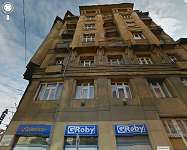
I was born here in 1934 (Erdélyi Street 19, second floor, apartment no. 3). This is where I spent the first ten years of my life with my whole family. In June 1944, the building became a yellow-star house. After the Arrow Cross takeover of power on October 16, the Arrow Cross broke into the house. They killed a half-witted boy on the spot, drove the residents out on the street with their hands up in the air, and made them march like this to a house (on what was I think Nefelejcs Road, but am not sure), where they were placed in another unknown apartment. Before this everyone was made to wait in the courtyard and if anyone had any jewelry, it was taken away. But we waited the whole night because the apartment was full of bedbugs. About 2 or 3 days later, the group was escorted by the Arrow Cross back to Erdélyi Street 19. As we learned later, the Arrow Cross leader’s lover lived in this house and came here to get some rest. This was lucky for us.
Then in November everyone had to move into the ghetto or a protected house. My mother, her brother, me and my younger sister found a place in a room at Sziget Street 40, where lots of other families lived, and the four of us slept in one bed. Seeing the impossibly cramped conditions, they managed to get me and my sister into a Calvinist institution, where we managed to survive the war. Meanwhile, my mother and her brother were deported to Bergen-Belsen in early December. Painful memories.
I hope that someone will read these lines and get in touch, because since then, I haven't heard anything about anyone.
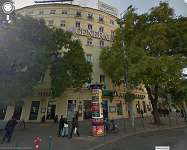
A slice from the history of the yellow-star house on the corner of Berlin (today Nyugati) Square, which I found in the memoirs of my grandmother, Margit Petrolay, entitled “The Little One in Hiding”:
“In such circumstances I decided to find my sister-in-law, about whom I only knew that she had moved out of her apartment. Not voluntarily. She had to move into a yellow-star house. The house stood on the corner of Berlin (later Marx) Square, near the Nyugati railway station, and where there was a pharmacist famous throughout the city. I knew that the owner was providing refuge for my sister-in-law and her daughter. I rang at the door of the third-floor apartment, where there was a sign hanging on the door. It was written in Hungarian, German and English, and said that the tenant was a British citizen and legally residing here. A woman opened the door. We introduced ourselves. I learned that she was working as an English governess. The family had moved to some unknown place, and entrusted the apartment to her. The Miss told me that an Arrow Cross group had been in the house the day before and ordered all the men to form lines in the courtyard, and then they took them away. She could not guarantee our safety. I found my sister-in-law, but it turned out that we had to leave this place. The concierge rang and told us that the Arrow Cross were here again, he had managed to divert them into his apartment and keep them talking there. But he warned us that we are not safe. The Miss had an idea: she would accompany us to the neighbor’s apartment. She asked the residents to take us in. They were not overly pleased to take in the visitors, but their humanity overcame that. They allowed the Miss to bring us into their apartment, while they retreated into the kitchen. This showed that they hadn’t invited us in. The room was cold and we didn’t dare turn on the light. We spend a good hour here until the concierge came to tell the Miss that the Arrow Cross were drinking in his apartment. We could hear their singing coming from his ground-floor apartment. We then thanked the residents for their hospitality, and returned to the apartment of the Miss and the pharmacist, and started packing right away.
My sister-in-law was very cautious and timid, and didn’t dare to leave her apartment and go out onto the street. Yet she still committed herself to my firm decision to move. Later, I looked over her bag, which contained things she would not need in the foreseeable future, such as a cookbook. I removed it from the bag but later, even before we left, it was back in there. I took it out again so she wouldn’t notice. Then she realized that there was no yellow star on her coat. I managed to convince her that from the point of view of what we were about it do, this was fine. We set off. We ventured out into the corridor, and then to the dark stairwell, and set off downstairs. Feeling our way from one step to the next, we made it down to the ground floor. To our horror, we found the front gate closed. A woman appeared in the gateway, I couldn’t see her but only heard her voice. She asked: are you them? What could I reply? I said yes, that’s us. Without a word, she opened the gate and we stepped out. A soldier was standing next to the gate. It never became clear, not even later, why he was standing there. Was he on duty? Did he have a date? But he didn’t stand in our way.
Holding the daughter’s hand, I quickly took her and her mother over to what was called the Banana Island. It was the terminus stop for lots of tram lines. We were in luck because there was a thick fog. You couldn’t make out any shapes. It was growing dark and it started to drizzle. I shoved my relatives onto the first tram that arrived and then got on myself. There was an empty seat right next to the door. Opposite me sat a woman, who noted quietly:
“They’re emptying out Pozsonyi Street and taking all the Jews away.”
How the woman had concluded that we were fleeing, I don’t know.
We got off the tram one stop earlier, afraid that someone was watching us and following. We arrived at the doss-house on foot. There were now two more of us again.”
Excerpt from Margit Petrolay, “The Little One in Hiding.”

We were a family of four: my father (Ede Unger), who had long been far away on forced labor service (in Transylvania?); my mother who was, typical for middle class families at the time, a housewife; my 17-year-old brother (János); and myself, aged 14. I cannot help noting that now, as the grandmother of one grown-up and one little grandchild, I look back at my mother’s heroic behavior with ever-growing admiration, and not even understanding how she could have endured this situation; at the way she not only coped, but—to use the contemporary expression—managed at the time alone with two adolescent children, and without a word of complaint.
The piano teacher, Renée Sachs was living with her mother—Auntie Aranka as I remember—in a ground floor apartment at Eötvös Street 31. “Auntie Renée,” my mother’s childhood friend, was my piano teacher. My mother was a great music lover, she used to sing in the famous Lichtenberg choir, and my grandfather, was no longer alive by then, had his own box at the Opera, my brother studied the violin, and I had piano lessons. This was how we ended up there.
The ground-floor apartment consisted of three front rooms, one backroom and a tiny maid’s room. (Kitchen, bathroom, toilet, hall.) The front rooms on the two sides were very small, previously these were the mother’s and the daughter’s bedrooms. The room in the middle used to be the living-dining-music room (the piano was there). The backroom was rented (then, as now, one could not live in luxury on a piano teacher’s pay!); a very sympathetic (non-Jewish) working couple lived there, with whom the tenants and later we got on very well. (Later on, when we were unable to listen secretly to (London) on our own radio as radio sets had long been confiscated, they listened to Moscow on their radio set, and sometimes, my brother and I sneaked in for these evening sessions.)
On June 21, 1944, the inhabitants of this apartment were: the Zámbó couple in the backroom, the original two tenants in one of the small bedrooms, two people, an elderly mother and her grown-up daughter in the small bedroom on the other side (unfortunately, I can’t remember their names, they were not staying for long as the Gestapo took them away for reasons we have never known). Mr. Mayer inhabited the entrance hall (I have never known anything about him), the three of us were in the middle room (mattresses on the floor), and in the maid’s room next to the kitchen stayed [the well-known composer] Leó Weiner, by himself! Altogether, 11 people. (I would like to note that Leó Weiner belonged to my mother’s social circle; it was an honor and great excitement when he first visited us in our old apartment, our home.)
It is well-known that all food was rationed, and even that was in shortage. There was a curfew for Jews, they were allowed out to the streets between 2 and 5 pm to buy food (I’m not quite sure of the hours), when even the few and poor quality foodstuffs were usually unavailable. Six of us (the two original hostesses, Leó Weiner and the three of us) had common meals at the dinner table standing “in our room.”
Interestingly, I can’t remember at all what the basement shelter was like, how so many of us could fit in, but there were surely air raid warnings between June 21 and November 21 (the period we were staying there, with a short break).
The building, which was a typical one with outside corridors looking over a central paved courtyard, housed very many people at this time. We became close with two families: that of Sándor Reschofsky, a professor at the Academy of Music whom Weiner had already known—their regular pastime was playing chess—and the Ferenczis, parents and a daughter of my age, the father used to be an army officer, and who still had his uniform, which of course he was banned from wearing. He was elected (or appointed?) as the air raid warden.
Because of the curfew, we practically spent the whole day in the building, with us youngsters outside in the courtyard. There was a member of almost every family who was taken away to places known or unknown; this, and the whole situation, made our mood generally depressed. I remember “small” episodes such as when a girl, who was a few years older than me, came back from “shopping” crying, because a well-dressed gentleman spat on her and pushed her down on the road—she wore the yellow-star as did all of us…
Sometimes in September, my father accompanying a forced-labor guard managed to come home for a day. It was the Day of Atonement (Yom Kippur, the day of 24-hour fasting), so there was nothing [to eat] for my poor father.
This was the way we lived until October 15, 1944. Having heard the proclamation by Horthy, everybody in the house was overwhelmed by extreme joy; my brother, together with many other youngsters, took off the yellow star and went for a walk in the evening.
Returning home, he reported happily that at the nearby Hotel Britannia (one of the German Headquarters), there was a hurried packing up and driving away in cars, motorcycles etc. As is well known, this joy didn’t last long and the worst was yet to come.
The first early morning round-up came on October 20, and all the Jewish men aged 16-60 years, including my 17-year-old brother were taken away (there were not many between the ages of 18 and 50, as they had long ago been conscripted for forced labor service).
I note here that our family had Swedish and Papal State (Vatican) protection letters (then I didn’t and still don’t know where these came from), but the Arrow Cross men were not impressed.
The next early morning round-up was on October 25, when women aged 15 to 50 were taken away. After her Swedish protection letter was torn apart by an Arrow Cross man, my (41-year-old) mother presented her Vatican protection letter, which helped, so she could stay behind.
Above us on the first floor, there was a young woman with a little girl, Noémi, aged about two (whose father was, of course, taken away long ago). She was everybody’s darling and, now that her mother had been taken away, the little girl remained there alone. The Zámbó couple living with us took her into their care and tried soothing her unremitting and desperate crying.
I would like to mention here two names of selfless gentile acquaintances—not even close friends—endangering their own lives, without whom I would certainly not be able to write these memories: Gyula Havalda (later Hámori) and his family (his wife and two sons Gyula and Viktor); Katalin Móricz.
We learned later that my brother was taken by the Arrow Cross men to a concentration camp near Pest, from where he escaped after a few days. He could not stay in a yellow-star house, therefore all three of us went to my mother’s friend Katalin Móricz, who lived on Angyalföldi Road. She let us stay with her on the condition that we wouldn’t go to the shelter during air raid warnings.
Since this was an industrial area, it was quite intensively bombed. Because of this and some other reasons (by then my mother’s nerves were shattered, as “living a lie” had worn her down, and also the situation of Kató [nickname for Katalin] was excessively endangered), after a couple days, we went back to the yellow-star house. In the meantime, my brother—I have no idea how—was smuggled in to one of the sewing workshops run by the Red Cross (Sütő Street 2), where many people were hiding.
In order to improve relations with the neighborhood Arrow Cross members, the workshop threw a party celebrating St Andrew’s day on November 30. Next day, on 1 December (my father’s birthday), the very same Arrow Cross men returned and took everyone away—employees and people hiding there. My brother never came back; the last uncertain news was from the Oranienburg concentration camp.
My mother and I were living in the house on Eötvös Street until 28 November, for us, this was end of the story in the yellow-star house.
It was the beginning of a much worse story. In the early morning (November 28), other Arrow Cross men came, who took us away to the ghetto. A large crowd was rounded up at Klauzál Square, which functioned as some kind of distribution center. If someone still had a wedding ring or a thin golden necklace, that was taken away there. Everybody was shoved towards a big bin and, under the scrutiny of Arrow Cross men closely watching, had to drop in whatever they had. A woman started crying hysterically, as she didn’t want to give away her wedding ring. She was immediately shot dead.
There were onlookers by the edge of the square and, among them, we discovered the sobbing Katalin Móricz. I wouldn’t know how she knew that we were there. She was soon sent away.
My mother and I were directed to Holló Street 1, where there was a prayer room on the first floor (or on the mezzanine?). We “lived” there. We were not allowed to leave the house, and were given daily some kind of liquid called soup, which we ate happily. For me, being cold was worse than starving. It’s known that it was a very cold winter.
On December 4, Kató Móricz turned up in the ghetto! She agreed with my mother that she would take me away and the next day, she would also bring my mother out too [of the ghetto]. She brought false papers, which were arranged by the above-mentioned Havaldas. The ghetto still had not been walled in. On the way out, we saw how the wooden panels were being put up, which would be locked and afterwards: neither in, nor out.
We went to Hajós Street 21, where I met my father; it was the last time I saw him. It turned out that my father temporarily stayed with the Havaldas, he also had false papers. From there, I was taken to Szabadság Hill by a gentleman unknown to me, Havaldas’s distant relative, whose family lived in the Havalda Villa at Normafa Street 11. I joined them as a refugee from Szeged [a town in South Hungary].
(Another story could be written about the time spent there, visiting the Catholic Church every morning, about the Communion, about living a lie, by the girl brought up to tell the truth.)
We were liberated on Boxing Day, but I had to wait until February 12, when the Germans broke out from the Castle. On February 13, 1945, I was picked up by the eldest son of a friendly family (who, by then, had come back from forced labor service).
At home I learned that my mother was unwilling to leave the ghetto, and later I heard that, during a raid, my father was caught by the Arrow Cross men and beaten to death. We waited a long time for my brother’s return.